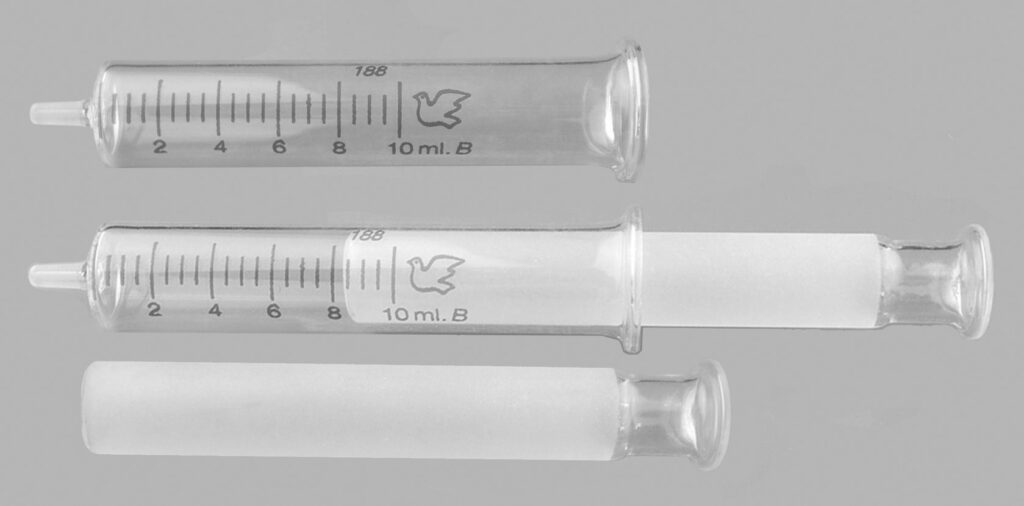
Until the middle of the nineteenth century, doctors had considerable difficulty in relieving the pain of their patients in that they could only administer medicines by mouth, enema, or suppository. The notion of injecting drugs into a vein had been stimulated by the attempts of Christopher Wren, Richard Lower, and Jean Baptiste Denys to transfuse animal blood into humans (1665–1667).1,2 But these methods were ultimately unsuccessful and the idea of using the intravenous route for pain relief was largely abandoned.
Doctors were thus limited to giving their medicines through the skin by applying them with a cloth and enhancing their absorption by vigorous rubbing, blistering agents, or caustics. They also tried smearing the drugs on the skin in the form a paste and then using a vaccination lancet to push them further on into the body.2 More promising, however, were attempts to deliver medicines by using piston barrel syringes and hollow needles, which had replaced the antiquated quills and silver or gold tubes. Syringes were developed by the French physician Charles Pravaz to treat aneurysms (1853), by Taylor and Washington of New York to deposit morphine into the tissues (1839), and by Francis Rynd of Dublin to administer morphine through small punctures into the skin along the course of nerves (1844).2 By 1853, several models of hollow needles and modern syringes had become available to physicians.
In 1853, Alexander Wood of Edinburgh made an important breakthrough. Having used a small hollow needle attached to a small syringe to destroy a mole or nevus, as was then the practice, he conceived the idea of treating the pain of what he called neuralgias by injecting morphine under the skin. He wrote:
Having occasion, however, about the end of 1853, to endeavour to remove a naevus by injection with the acid solution of perchloride of iron, I procured one of the elegant little syringes constructed for this purpose by Mr. Ferguson of Giltspur Street, London. While using this instrument for the naevus, it occurred to me that it might supply the means of bringing some narcotic to bear more directly than I had hitherto been able to accomplish on the affected nerve in neuralgia. I resolved to make the attempt, and did not Iong lack the opportunity.2
Wood used cherry wine because he thought this might be less irritating than alcohol, and found that his injection provided immediate relief. At first, believing that the pain was relieved due to an effect on the peripheral nerves, he was not interested in the systemic effect of the drug.3 In fact, he reported being annoyed when an elderly patient slept for twelve hours after he had injected her with a large dose of morphine, about 25 mg.Over the next two years he experimented with his new method on eight further cases.4
There had been earlier reports of physicians trying a similar approach and claiming priority,2 but Wood is considered to be the true inventor and his method was widely adopted. In London, the surgeon Charles Hunter conducted his own studies.4 By 1858 he had come to understand that the pain was relieved mainly by its effect on the central nervous system rather than by a local action. He wrote that repeated injections into the site of the pain, “an unsound or morbidly sensitive part,” increased the risk of producing an infection as well as being more painful than using a remote site.2 He described the needle he used and gave an illustration of it. He called his method the “hypodermic” route, by contrast to Wood, who called it the “subcutaneous” route. Many modifications subsequently followed: better needles and syringes, the Luer lock connection, and a single cartridge system.
Most of the credit for this important advance undoubtedly goes to Alexander Wood. He made no fortune from his invention and at the time gained little fame, even though his method became universally used.2 But credit is also due to Charles Hunter for emphasizing that although the medications were injected locally, they exerted their effects remotely by acting on the central nervous system.
Further reading
- Dunea G. Xenotransfusion: Blood from animals to humans. Hektoen International Winter 2022.
- Mogey GA. Centenary of hypodermic injection. BMJ Nov 28, 1953;2:1180.
- Wood A. Treatment of neuralgic pains by narcotic injection. BMJ Aug 28, 1858:721.
- Brunton D. A question of priority: Alexander Wood, Charles Hunter and the hypodermic method. J Royal College of Physicians Edin. 2000; 30:349.

Leave a Reply